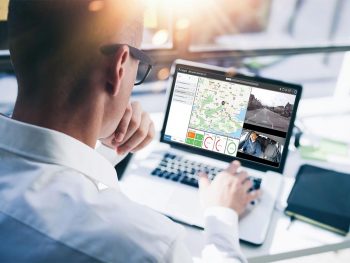Technology Focus: The latest developments for fleets
Latest cutting-edge fleet technology developments can help fleets and drivers improve efficiency. Fleet World picks out a selection.

Trakm8 says its latest vehicle camera solutions are a big step forward for drivers and fleet managers alike
Cameras in focus
For many businesses, fleet vehicles are among the most significant investments they will ever make. Safeguarding those assets – thus maximising ROI – is, clearly, a key consideration.
Trakm8’s RH600 dashboard camera is designed to help organisations best protect those fleet investment. Billed as the most advanced 4G telematics camera available globally, the RH600 represents a big step forward in vehicle camera technology for drivers and fleet managers alike. For example, the camera has been adopted by some of the most recognisable names in UK business. In shoring-up fleet safeties and efficiencies, the RH600 has been proven to decrease accident rates by up to 39%; reduce insurance claims by up to 50% and decrease speeding incidents by up to 35%. What’s more, the company claims that, by using the RH600, fleets can improve fuel economy by up to 10%.
The RH600 is built on the rich data collected by Trakm8’s intelligent telematics devices, with a cutting-edge in-cab camera provision. This blend of insight and hardware makes RH600 an advanced, but cost-effective solution for the fleet industry.
Trakm8 says one of the key strengths of the RH600 is its versatility. Usable as a traditional dash cam, there’s a dual-camera function, which provides a 280° field of view, delivering valuable peace of mind and making the gathering of post-collision evidence easier than ever before. What’s more, the ultra-HD cameras provided ‘crystal clear footage’ from the driver’s perspective; a valuable tool through which to mitigate claims of poor or distracted driving.
Meanwhile, Trakm8 has also recently launched the ACC750, which combines a dynamic driver identification and feedback solution with the business’s wider telematics regimen.
Using the ACC750’s driver feedback display improves driver behaviour and minimises fuel inefficient driving habits, such as heavy-footed braking and revving. By rewarding better driver habits, the system allows fleets to proactively reduce fuel consumption by both providing real time feedback and tracking specific behaviour trends.

Vehicle movement specialist Engienius has technology at the heart of its offering
Tech back control
Today’s clients demand technology with greater control and transparency and rightly so, because every customer can enjoy the benefits of the latest retail, banking and booking sites for everything from a holiday to a tee-time. But are the same advantages being replicated in a typical B2B scenario?
Technology is at the core of vehicle movement specialist Engineius’ offering – and it is what differentiates it from the other players in the sector. Customers are offered an on-demand service that allows them to book jobs directly and replicates the online retail experience they know and love. Similarly, there is no minimum usage requirement, no licence fee and the whole customer journey is managed by Engineius.
“Our customers want to be in control. They enjoy the ability to select and book their vehicle movement in the same way they are accustomed to for their retail purchases,” says Tris Benson, commercial director of Engineius. “They expect vehicle photography and then, they want to be able to track the delivery.
“Our tech provides this transparency, delivers cost savings and the additional benefits commonly realised through outsourcing, whilst most importantly allowing them to retain confidence and control over their vehicle movements.”
The use of the mobile phone is now commonplace, so integrated mobile phone technology allows Engineius to liaise with customers via text saving time and money. Customers can specify criteria for advance text alerts. This use of technology makes for a better experience for the fleet client, the driver and the end recipient.
On completion of a vehicle movement, customers receive text messages requesting feedback via a short survey, as do the drivers, creating ‘360°’ feedback, prompting continuous dialogue between Engineius and customers keeping them at the helm in designing and improving operations.
“Customers are empowered with Engineius’ tech, our tech enables us to provide the fleet client with an unparalleled level of transparency throughout the process.”

Geotab has previously demonstrated that nearly 40% of UK fleet vehicles could go electric today and still save money
Keep a tab on your EV fleet
Geotab says its Electric Vehicle Suitability Assessment (EVSA) tool is powered by the largest dataset for real-world Electric Vehicle (EV) performance. Specifically, it uses telematics data to understand a fleet’s specific needs and makes considered recommendations for fleet operators considering a transition to zero emission vehicles.
With the ability to measure real-world EV performance metrics against existing fleet vehicles, the EVSA can uncover potential real-world financial savings and environmental benefits to help fleets electrify with confidence.
By analysing your fleet’s unique driving profiles and patterns, the tool is able to identify the vehicles in a fleet that are most suitable for EV replacement. That process includes providing personalised recommendations, down to the make and model of the vehicles in question. Not only that, but it can take into consideration local availability, EV performance in extreme weather conditions and financial costs related to procuring the vehicles themselves.
By using the tool, three key questions can be answered:
- Which vehicles can be transitioned?
- Does it make economic sense to go electric?
- What are the environmental benefits of electrification?
Transitioning to electric vehicles is not the only way to reduce a fleet’s carbon emissions, of course. There are many best practices, powered by data-driven insights, that are delivered through the EVSA tool, that fleet managers can use to make their entire fleet more sustainable. Fleet right-sizing, route optimisation and idling time reduction provide some of the biggest opportunities to reduce carbon emissions from fleet operations, while also reducing costs.
Geotab recently conducted a research study to better understand how compelling the ‘switch to electric’ can be for fleets. Using a de-identified dataset of driving patterns for 46,000 connected ICE vehicles across 17 European countries, the company found compelling evidence around the return on investment (ROI) and the positive sustainability impact of switching to EVs today.

Nauto says sophisticated predictive-AI safety tech is a path to mitigate risky behaviours
A safety first
More than 90% of collisions involve human error, but one single error stands out from the rest: distracted driving. In 2019, the UK saw more than 2,500 road traffic accidents where ‘distraction inside vehicle’ was cited as the contributory factor. Shockingly, 65 of these accidents were fatal.
Commercial drivers, who receive training and are generally safer drivers, are still more at risk because they operate larger vehicles and tend to drive more miles and hours. However, unlike passenger cars, there is technology available today in the fleet segment that alerts drivers by accurately detecting risky driver behaviour and dangerous road scenarios that engender collisions. Unlike the dashcam and first-generation safety AI solutions, only certain sophisticated predictive-AI safety tech has the ability to fuse internal and external risks and provide enough advanced warning time to help reduce collisions. For fleet owners, this is a path to mitigate bad news before, not after, an incident occurs.
One such solution, Nauto, can trigger alerts in real-time to help drivers avoid more than half of collisions and self-coach to reduce the frequency of risky behaviours that lead to collisions by 80%. It is designed to detect more collision scenarios and high-risk activities – like drowsiness – with up to 99% accuracy to give drivers as much as several seconds of critical extra time to help prevent collisions and save lives.
Fleet drivers are finding automatic performance improvement within weeks of deployment. The system acts like a trusted co-pilot by analysing the surroundings and understanding the driving context and fuses all these elements together in real time. Nauto is designed to give the driver a clear, real-time warning to discern whether the situation is heading in a troublesome direction or if there is the likelihood of an imminent collision over the next few seconds. All this can be done without the privacy intrusion of video cameras required for older telematics and supervisor coaching systems.
Loram Maintenance of Way, a road and rail maintenance specialist, has been using Nauto since 2018 as a solution to help eliminate distracted driving across its fleet. Since adopting Nauto, the company has seen a 79% reduction of at-fault accidents and a sizeable drop in tailgating and mobile phone usage.

Barney Goffer, UK product manager at Teletrac Navman
Four main technology trends for 2023
The adoption of technology across the transport and fleet industry has risen considerably in recent years and Teletrac Navman says there are four main fleet technology trends for 2023.
Artificial Intelligence (AI) in transport
AI-powered tech is all about the intelligence gained. It can instantly analyse and interpret data to provide insights and the ability to make more informed decisions. Transport businesses work with huge amounts of data each day, so it is critical to have an AI-powered solution that not only collects data but interprets it, to add greater value and understanding.
An AI and machine-learning-based platform allows businesses to streamline processes, predict trends and gain real-time insights. This, in turn, helps to identify inefficiencies to boost productivity and improve driver behaviour, for the safety of all road users. What’s more, according to McKinsey, by 2030 it’s expected that AI could add $13 trillion to global economic output.
Growing uptake of smart cameras across fleets
AI-enabled smart dashcams are fast being adopted by forward-thinking organisations because they provide visibility far beyond just video and audio. In fact, Berg Insight forecasts a CAGR of 16.8% for video telematics, from almost 3.9 million units at the end of 2021, to 8.4 million by 2026 across Europe and North America.
They’re indispensable for helping to reduce road incidents and insurance premiums, prevent fraudulent claims and identify ways to improve driver behaviour. Built-in sensors show what’s happening inside and around the vehicle in real-time. From distracted driving to dangerous following distances, fleet managers can use the data to encourage drivers to improve safety and performance. AI-enabled tech also learns from its environment, meaning it gets more accurate with time.
Electric vehicles
EVs will represent 48% of all new cars sold globally in 2030, according to the Electric Vehicle Outlook: 2021 and Beyond report. To put this into perspective, BloombergNEF predicts global EV sales will leap by 14 million units in 2025, accounting for around 16% of all passenger-vehicle sales.
Technology improves with market uptake, so as more people welcome EV ownership, cost and availability will improve as a result. Fleet managers need to take the growing use of EVs into account for future planning, factoring in costs for battery charging, repair and transition, as we move into tomorrow’s fleet, today.
A driver safety focus
Safety is a growing concern for drivers and fleet managers, and for good reason. According to the World Health Organization, approximately 1.3 million people lose their lives to road traffic accidents globally. Something the United Nations General Assembly takes seriously, with its work towards a target to halve the global number of deaths and injuries from road traffic crashes by 2030.
So, what can fleet managers do to support this goal? Put driver safety right at the top of the agenda. The benefits of fleet technology in addressing safety concerns are becoming more common place. Real-time data produced by telematics means that fleet managers can create individualised training and coaching programs for drivers in need, as well as reward positive behaviour. In turn, improving driver retention which is vital against the backdrop of continued driver shortages.
What’s next for technology?
In this increasingly digitised world, data is only truly valuable if it is interpreted to produce insight and in turn, action. Advanced AI technology is the most effective way for fleet managers to optimise and learn more about their fleet, through more informed decisions and impactful changes.
2023 is expected to be another pioneering year for tech in transport and as uptake increases, this will pave the way for continued growth and innovation for safer, more efficient and better-connected fleets and the industry as a whole.

















